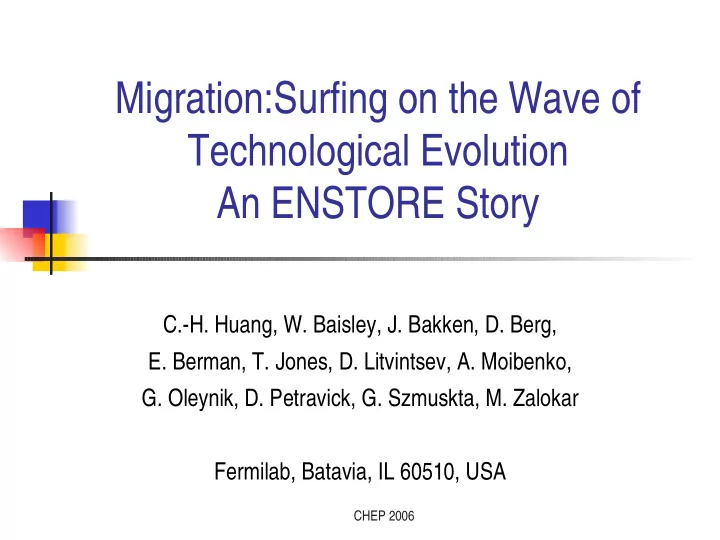

Migration:Surfing on the Wave of Technological Evolution An ENSTORE Story C.-H. Huang, W. Baisley, J. Bakken, D. Berg, E. Berman, T. Jones, D. Litvintsev, A. Moibenko, G. Oleynik, D. Petravick, G. Szmuskta, M. Zalokar Fermilab, Batavia, IL 60510, USA CHEP 2006
Introduction ENSTORE petabyte scale permanent storage system tape based system developed by and installed at Fermilab highly available in service for 8 years 36,000+ volumes, 15,000,000+ files, 3.5 petabytes and counting CHEP 2006
Nature of a Tape Based MSS Cost structure total capacity = number of media X density online capacity is limited by library library is limited by physical facility everything is limited by $$$ increase density, increase total capacity CHEP 2006
Nature of a Tape Based MSS Performance maximal system performance is limited by the sum of individual drives’ performance increased drive performance increases overall system performance Go for high density media and high performance drives CHEP 2006
Challenge for Long Running Production Systems Technologies evolve newer media with higher density better price/capacity newer drives with better performance better price/performance Sticking with older technologies costs more! CHEP 2006
Taking Advantages of Newer Technologies Migrate data onto newer media Drive change often requires media change Example of 9940A to 9940B migration same physical cartridge different formats 3 times capacity increase (60GB to 200 GB) 3 times performance increase (10MB/s to 30MB/s) Migrating data from 9940A tapes to 9940B tapes and recycling/reformating 9940A tapes to 9940B format increase the capacity and performance by a factor of three under the same physical and fiscal constraints CHEP 2006
Conceptual View of ENSTORE Front end name space Provides a file system like interface to users Pnfs is the current implementation Back end storage system Self sufficient with internal database for metadata Loosely coupled front end and back end Same metadata is stored in both places Deleted files are never removed unless the media is recycled CHEP 2006
Conceptual View of ENSTORE Front end name space Back end storage system PNFS FILE DB pnfs entry file record pnfs entry file record user files on tape CHEP 2006
Design Considerations File based migration Files are always available Transparent to users No reserved resources for migration Minimal impact to system performance Complete transaction history log Minimal administrator attention Concurrent migration streams Reversible CHEP 2006
Implementation File migration in three steps Copying file Swapping metadata Read back verification Batch mode (by tape) As above Deferred verification More complicated error handling Optionally migrate deleted files CHEP 2006
Before migration Users access file f1 through pnfs entry p1 PNFS FILE DB t1 p1 f1 CHEP 2006
Step 1: Copying file file p1/f1/t1 is copied through disk to file p2/f2/t2 f1 and f2 are distinct files of same content PNFS FILE DB t1 p1 f1 t2 p2 f2 CHEP 2006
Step 2: Swapping Metadata a pair of one way copies f2 is immediately accessible PNFS FILE DB t1 p1 f1 t2 p2 f2 CHEP 2006
Step 3: Verification p1 reads f2 f1 is marked deleted and, if there is a need, can be restored PNFS FILE DB t1 p1 f1 t2 p2 f2 CHEP 2006
Other Applications Media cloning Cloning tapes without reserved resources Media compaction Reclaiming space occupied by deleted files Media consolidation Combining partially filled media to fewer ones CHEP 2006
Experience and Concluding Remarks Migration in production for more than 2 years Success story 2004: 4557 9940A tapes to 9940B migration Triple the library capacity 2005: 1240 eagle tapes to 9940B migration Reclaim 1000 needed slots in the library Migration becomes a routine task in ENSTORE Keeps surfing on the wave of technological evolution CHEP 2006
Recommend
More recommend